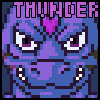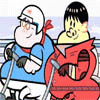
Just something quick--I wanted to stretch creatively for the night before exhaustion knocks me out.
Biology:
The waterbaby is a xenorelative of the roly-poly bug, which is actually a crustacean, like a crab or lobster, but manages to live on land in moist areas by constantly sucking up water from the ground to maintain its pseudolungs. Unlike the Roly-Poly, the Waterbaby can grow to a meter in diameter in captivity, but usually average half of that in the wild.
The waterbaby takes it a step further, forming leathery-thick-skinned ball of modified keratin to store moisture it sucks up through its modified mouth and spongy pads underneath its body. Surrounding this globe of water is the Waterbaby's body, comprised of a rubbery exoskeleton made of overlapping plates.
If startled, the Waterbaby can eject the entire globe with surprising force, completely soaking a potential predator, and in the subzero climate inhabited by the Waterbaby, a drenching can mean near-instant death for predators in flight.
The most noticeable feature of the waterbaby is its shaggy pelt, giving it the appearance of a fluffy ball. In the mountainous regions inhabited by the Waterbaby, the dark, puffy fur traps sunlight and heat.
Pregnant individuals (asexual) create a specialized thicker-skinned globe filled with eggs, storing them until an appropriate mate can be found, then carrying them until the eggs hatch. The Waterbaby undergoes a period of dehydration at this as all water goes towards sustaining the eggs.
Ecology
The Waterbaby is native to spire-like mountaintops, where most of the available water is locked in the frozen sheets of slate that rise vertically from the mountain ranges. Waterbabies can be found climbing to the vertical surfaces, their underpads providing both grip and working to extract water from the stone.
Susceptible to predators at lower altitudes, where a watery drenching is less a deadly threat and more of an inconvenience, Waterbabies are nonetheless often kept as farm animals, useful not for meat, for for their ability to extract water from even the most unforgiving environments. If properly handled, the globe can be extracted from a Waterbaby and used as drinkable water. With ample water, a Waterbaby can then regenerated a new globe within a week.
As Pets
Because of their lush fur, soft, flexible plates, and rubbery, pliant globe, Waterbabies are popular pets for those wanting a soft companion to cuddle. The flexibility and compressability of a Waterbaby is extraordinary, and any point other than the head may be squeezed to as narrow around as four centimeters.
Care should be taken that a Waterbaby not overheat. Though adapted for arctic temperatures, Waterbabies are comfortable in any cool environment, and will move for shade if overheated, and will show signs of overheating by rapidly "rippling" its fur to release excess heat.
In the wild waterbabies feed on lichens dead animal and plant matter, and require very little food to survive and even less water. If provided with too much food or water, a Waterbaby will begin leaving globes around a dwelling. Too much food results in thick-skinned, small globes, while too much water results in thin-skinned large globes which often leak if left to their own devices.
Waterbabies can wreak havoc on houseplants and fruits, climbing over them and draining water from them, usually killing small plants and leaving fruits with dry "dents."
Biology:
The waterbaby is a xenorelative of the roly-poly bug, which is actually a crustacean, like a crab or lobster, but manages to live on land in moist areas by constantly sucking up water from the ground to maintain its pseudolungs. Unlike the Roly-Poly, the Waterbaby can grow to a meter in diameter in captivity, but usually average half of that in the wild.
The waterbaby takes it a step further, forming leathery-thick-skinned ball of modified keratin to store moisture it sucks up through its modified mouth and spongy pads underneath its body. Surrounding this globe of water is the Waterbaby's body, comprised of a rubbery exoskeleton made of overlapping plates.
If startled, the Waterbaby can eject the entire globe with surprising force, completely soaking a potential predator, and in the subzero climate inhabited by the Waterbaby, a drenching can mean near-instant death for predators in flight.
The most noticeable feature of the waterbaby is its shaggy pelt, giving it the appearance of a fluffy ball. In the mountainous regions inhabited by the Waterbaby, the dark, puffy fur traps sunlight and heat.
Pregnant individuals (asexual) create a specialized thicker-skinned globe filled with eggs, storing them until an appropriate mate can be found, then carrying them until the eggs hatch. The Waterbaby undergoes a period of dehydration at this as all water goes towards sustaining the eggs.
Ecology
The Waterbaby is native to spire-like mountaintops, where most of the available water is locked in the frozen sheets of slate that rise vertically from the mountain ranges. Waterbabies can be found climbing to the vertical surfaces, their underpads providing both grip and working to extract water from the stone.
Susceptible to predators at lower altitudes, where a watery drenching is less a deadly threat and more of an inconvenience, Waterbabies are nonetheless often kept as farm animals, useful not for meat, for for their ability to extract water from even the most unforgiving environments. If properly handled, the globe can be extracted from a Waterbaby and used as drinkable water. With ample water, a Waterbaby can then regenerated a new globe within a week.
As Pets
Because of their lush fur, soft, flexible plates, and rubbery, pliant globe, Waterbabies are popular pets for those wanting a soft companion to cuddle. The flexibility and compressability of a Waterbaby is extraordinary, and any point other than the head may be squeezed to as narrow around as four centimeters.
Care should be taken that a Waterbaby not overheat. Though adapted for arctic temperatures, Waterbabies are comfortable in any cool environment, and will move for shade if overheated, and will show signs of overheating by rapidly "rippling" its fur to release excess heat.
In the wild waterbabies feed on lichens dead animal and plant matter, and require very little food to survive and even less water. If provided with too much food or water, a Waterbaby will begin leaving globes around a dwelling. Too much food results in thick-skinned, small globes, while too much water results in thin-skinned large globes which often leak if left to their own devices.
Waterbabies can wreak havoc on houseplants and fruits, climbing over them and draining water from them, usually killing small plants and leaving fruits with dry "dents."
Category All / Fantasy
Species Unspecified / Any
Size 694 x 971px
File Size 445.5 kB

 FA+
FA+













Comments